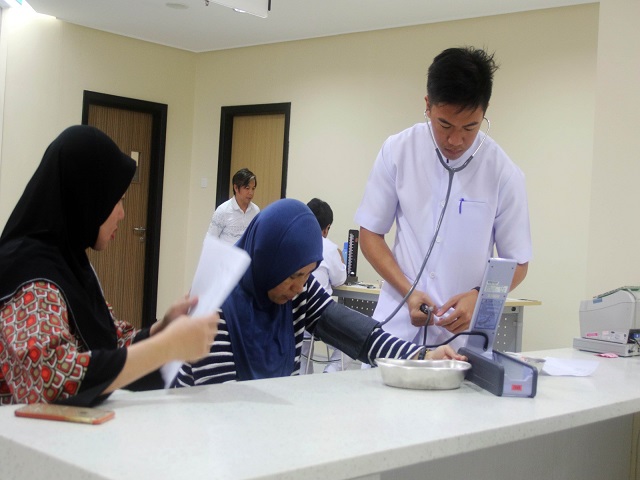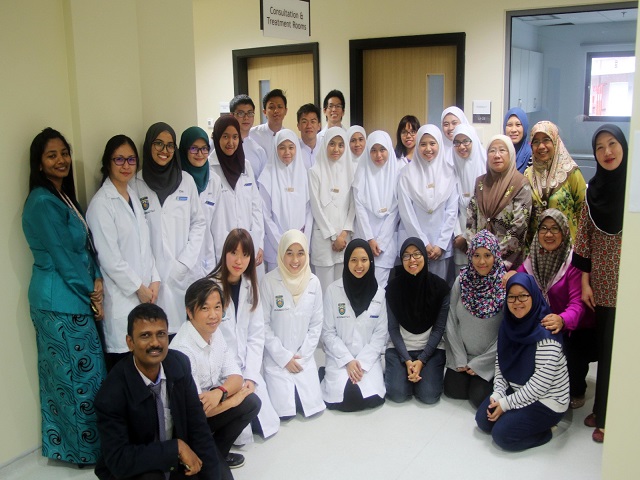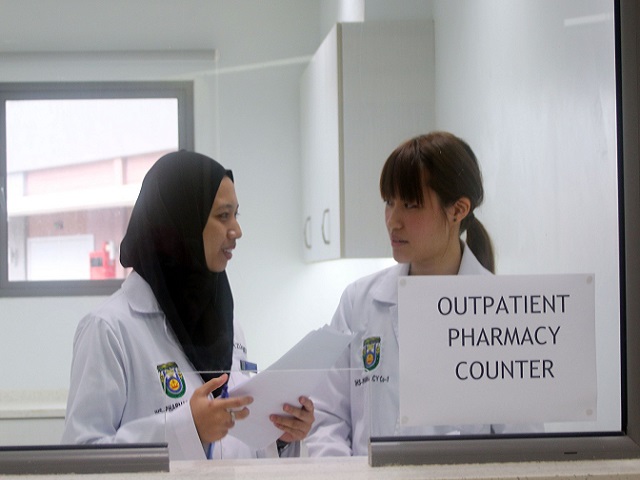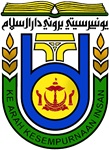
Reception Counter at Simulation Area
Strengthening team work in Health Care Professional Team: Interprofessional Simulation Education
First year Nursing students were in the triage and first year Pharmacy students were dispensing and counselling the patient. This was the scene in February 2017 in IHS Simulation Clinic. This was part of Interprofessional Education (IPE) at the PAPRSB Institute of Health Sciences (IHS). IPE has been recognised internationally as a way to improve healthcare professional interactions and team working in order to enhance patient care. Working together for patients requires teamwork. IPE helps to improve healthcare services through interprofessional working and to appreciate other professionals’ roles and responsibilities and experience the different working practices. Simulation Education has the motto of “Shaping the Future Health Professionals”.
The SimCentre of IHS has been expanding its scope in IPE across the health professions. Integration of healthcare students as a team through IPE activity is considered as one of the best ways to promote early, and subsequently sustain, the principles of teamwork.

Staff and Students of Nursing and Pharmacy Programmes
A case scenario of a patient diagnosed with rheumatic heart disease being prescribed with an antibiotic but has a family history of severe allergic reaction to an antibiotic was given. The third-year Diploma in Health Science nursing students became the simulated patients and played an important role in the success of the simulation. The nursing students were doing the initial triage, full history taking and assessment and then passed on the information to the pharmacy students. The pharmacy students then dispensed the prescribed medications to the patients and ensued counselling and health education to the patient. Later, the pharmacy students informed the nursing students to administer the prescribed medications and make observations. All findings, plan of action and intervention should be communicated clearly among the team members. The knowledge, teamwork, leadership and decision making of the students came into play to manage this scenario.
Throughout the IPE-Sim activity, the facilitators observed the performance of the students for debriefing purposes. During the debriefing, students reported that they learnt a lot from IPE-Sim which helped them to identify their strengths and weaknesses. Being their first IPE-Sim some of them were very nervous and felt that they were not doing well enough; however, overall, this IPE-Sim was a success and offered room for further improvement.
“We all have a moral obligation to work together to improve care for patients.” Pronovost & Vohr, 2010
On 18th February 2017, the second event of Interprofessional Education - Simulation (IPE-Sim) was conducted in the PAPRSB Institute of Health Sciences, Simulation Clinic. The IPE-Sim involved the participation between 9 first year Bachelor in Health Sciences Pharmacy students, 16 first year Bachelor in Health Sciences Nursing students and 1 second year Bachelor in Health Sciences Midwifery student. This was facilitated by 5 members of IHS Simulation Team, 1 midwifery lecturer and 3 senior pharmacy lecturers.
The scenario was carefully designed and planned by the Programme Leader of Bachelor in Health Science -Pharmacy and the Simulation Team few weeks before implementation. Logistics and prerequisites were prepared by the simulation technicians. The aim of IPE-Sim activity was to cultivate collaborative learning experience among the students in providing effective clinical assessment, health education in dispensing and administering medication to the patient.

History Taking Simulation

Simulation at Pharmacy Counter
Working together for patients requires teamwork.
Simulation Education has the motto of “Shaping the Future Health Professionals”.
A major advantage of this activity was encouraging less confident students to overcome their fear to communicate and to build on their self-confidence. From this IPE-Sim, facilitators impressed upon the students that communication skill was an important area that should be gradually improved, especially for communicating with patients.
This IPE-Sim has simply brought both healthcare professionals together and an amicable collaboration to take place. Students learnt to appreciate each other’s roles as professionals and recognised their own individual scope of practice and skill set. It also created an awareness and appreciation for other health professionals’ capacity to contribute to the delivery of care to patients in order to achieve optimal health outcomes. Further sessions of IPE-Sim have been planned for fostering and strengthening the teamwork of future health care professionals.
